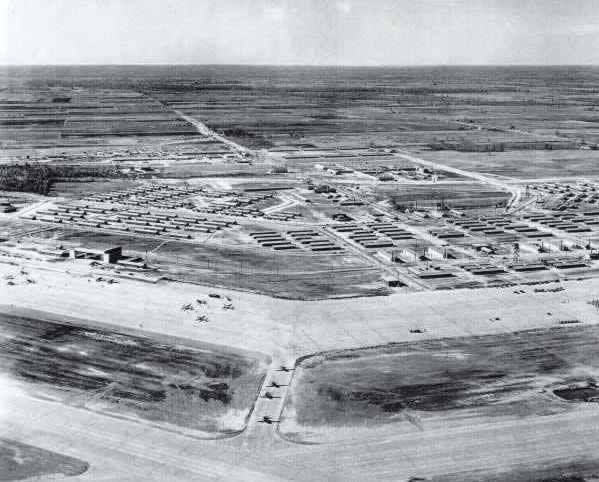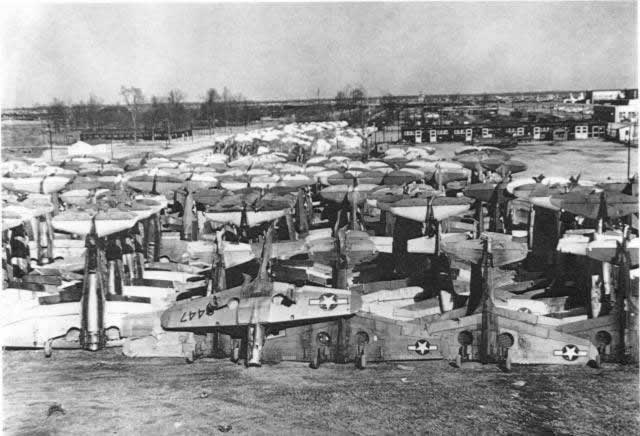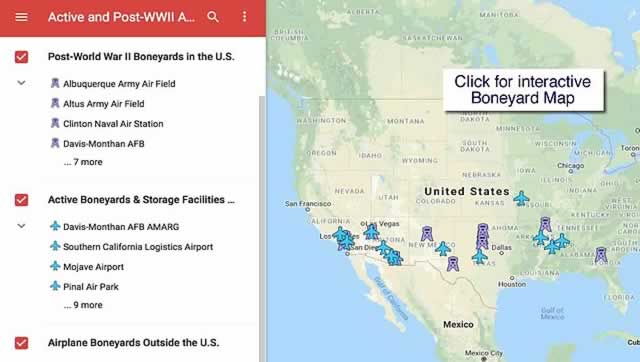
Walnut Ridge Army Air Field in Arkansas
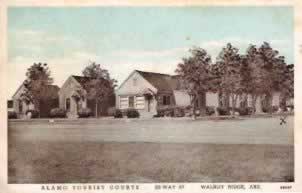 Housing during the construction of the air field was at a premium. Local residents opened their homes to workers, motels were full. Seen here: Alamo Tourist Courts, Walnut Ridge, Arkansas |
Walnut Ridge is located in northeast Arkansas, about 25 miles from Jonesboro, at the intersection of U.S. Highways 63, 67, and 412.
It is about 90 miles northwest of Memphis, Tennessee, and about 125 miles northeast of Little Rock. To the north of Walnut Ridge is the town of Pocahontas.
Construction of Walnut Ridge Field and Usage During World War II
In response to satisfying World War II requirements, the U.S. government decided to create an Army Air Forces Flying School. It originally picked a location in Dyersburg, Tennessee, but a Board of three Army Air Forces Officers continued the search.
Their flight brought them over an area just northeast of Walnut Ridge, Arkansas, which looked promising. Returning by car the next day, the Board looked over the site, and checked on the schools, housing, utilities and transportation. The Board was favorably impressed with the Walnut Ridge location, and on April 15, 1942, recommended it be substituted for the Dyersburg site. The Dyersburg site was unfeasible due to the millions of cubic yards of dirt would have to be moved in order to construct the runway.
|
The Board’s recommendation was approved, and on May 12 the War Department directed the Army Corps of Engineers to construct a Basic Flying School at Walnut Ridge with three runways and plan for more. The 3,096 acre site chosen was about 6 miles northeast of the town of Walnut Ridge.
Construction of the airbase began on June 20, 1942. The new air field brought new prosperity to most people in Lawrence and Randolph Counties as more than 1,500 worked moved into the area to handle the construction. Housing was at a premium, and many opened their homes to workers.
Designed for 5,114 military personnel, and 976 civilians, the Walnut Ridge Air Field had three 5,000-foot runways, a huge apron covering over 63 acres, four large hangars, base engineering building, and fully equipped 203 bed hospital.
The flying school officially opened on August 15, 1942, and began training its first class of cadets. Over the next two years, pilots were trained to fly BT-13s.
In the last year of the war, the airbase was also used to hold German POWs. The Army Air Force's use of the airbase officially ended in 1944, when it was traded to the Marine Corps, becoming the Walnut Ridge Marine Air Facility.
Post-World War II Years at Walnut Ridge
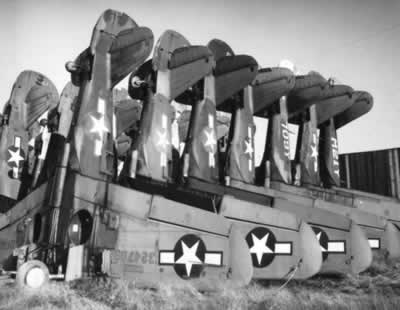 Curtiss P-40 Warhawks stacked on their noses to save space at Walnut Ridge, Arkansas after World War II (Photo courtesy of Walnut Ridge Army Flying School Museum) |
Once peace was assured, the military found itself with a huge surplus of aircraft. The United States had manufactured about 294,000 aircraft for the war effort. A study was conducted to determine the most cost effective way to dispose of planes; it was determined that too many man-hours were required to dismantle planes for parts, and the cost for storage areas for the parts was too high.
So the method of "salvage and melt" was adopted. Main components such as engines, armament, instruments and radios were removed from each plane. The remainder of the aircraft was cut into pieces, and pushed in a large furnace, or smelter. Aluminum was the prime metal sought after, melted and poured into ingots for sale and shipping.
Planes were then assigned an airport, at places like Kingman in Arizona and Walnut Ridge for short-term storage and subsequent disposal, or Davis-Monthan AFB in Tucson or Pyote AAF in Texas for longer-term storage.
Walnut Ridge was an ideal site for surplus aircraft storage because of its large land area and large parking ramp. As many as 250 airplanes arrived each day. An estimated 10,000 to 11,000 warplanes were flown to Walnut Ridge in 1945 and 1946 for storage, sale, or scrapping.
The two smelters used to melt the aircraft at Walnut Ridge were torn down in 1952.
Types of Aircraft Sent to the Walnut Ridge Boneyard After WWII
 Walnut Ridge Army Air Field, showing stacks of warbirds awaiting salvage after World War II |
Among the other aircraft types and quantities shipped to Walnut Ridge for storage or smelting were the following:
- 191 C-47 Skytrain
- 86 C-54 Skymaster
- 369 C-46 Commando
- 1,211 Boeing B-17 Flying Fortress
- 1,148 B-24 Liberator
- 513 B-25 Mitchell
- 261 B-26 Marauder
- 462 Curtiss P-40 Warhawk
- 100 P-38 Lightning
- 347 Republic P-47 Thunderbolts
- 102 North American P-51 Mustangs
- 65 of the military’s 118 Consolidated B-32 "Dominator" heavy bombers, many straight from the assembly line in Fort Worth
- and others
Modern-Day Walnut Ridge Municipal Airport
In 1947, the United States government formally turned the base over to the City of Walnut Ridge. Part of the airbase was converted into a municipal airport. Southern Baptist College, now known as Williams Baptist College, took possession of 122 acres of the land, using it for student housing and educational buildings. The rest of the former air base was converted into an industrial complex.
Today, Walnut Ridge Municipal Airport (IATA Code ARG) remains an active 1,800 acre facility. It features three runways ranging in length from 5,000' to 6,000'. A group interested in preserving the air field’s history created in 1999 a museum commemorating the air base and the people who served there. The Wings of Honor Museum - Walnut Ridge Army Flying School Museum is located nearby today.
Historic Photos of Walnut Ridge Army Air Field
Early view of the Walnut Ridge Air Field (Provided by the Walnut Ridge Army Flying School Museum) |
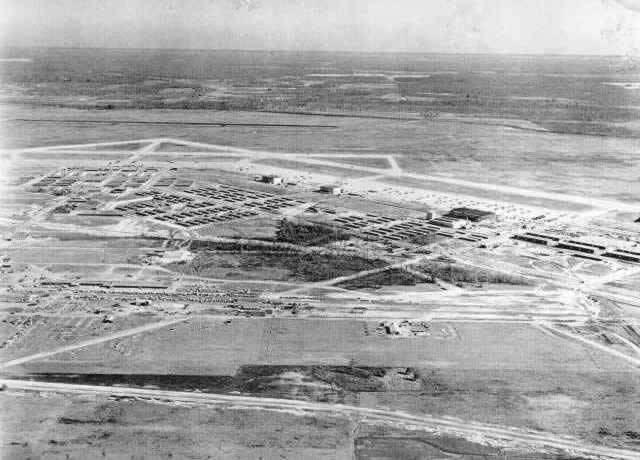 |
Base Operations at the Walnut Ridge Air Field in Arkansas during World War II (Photo courtesy of the Walnut Ridge Army Flying School Museum) |
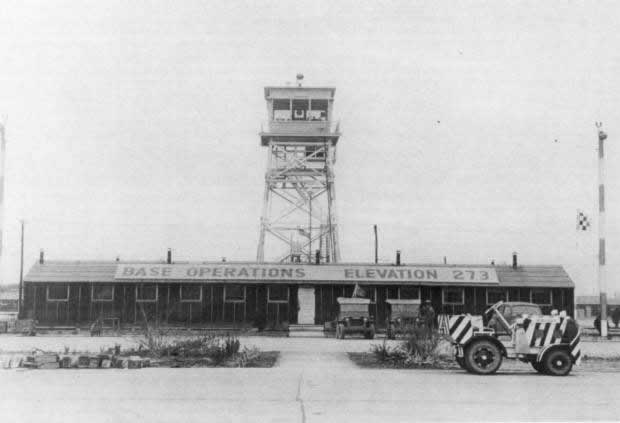 |
Aerial view of surplus U.S. military aircraft at Walnut Ridge, Arkansas, in November, 1945 (Walnut Ridge Army Flying School Museum) |
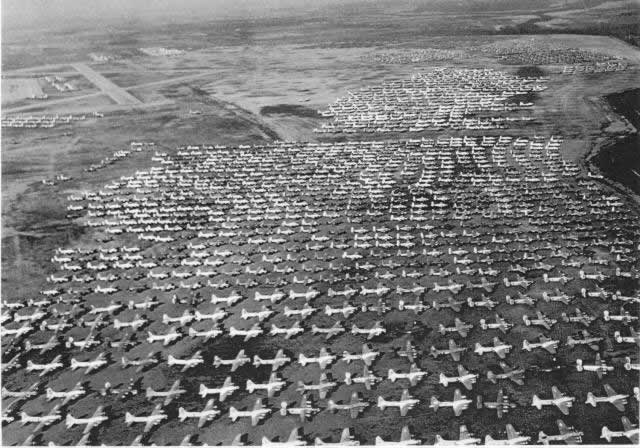 |
Convair B-32 Dominator bombers stored at Walnut Ridge, Arkansas, after World War II Of the 118 B-32s that were built, 67 of the Dominators were sent to Walnut Ridge (Walnut Ridge Army Flying School Museum) |
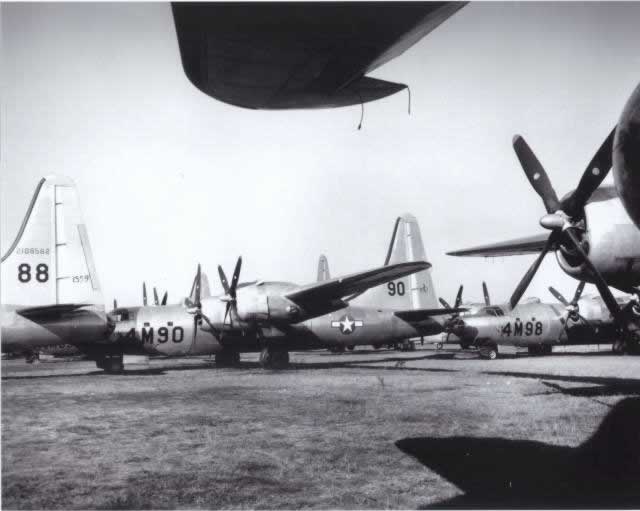 |
Rows of C-54 transport aircraft stored at Walnut Ridge, Arkansas, after World War II (Walnut Ridge Army Flying School Museum) |
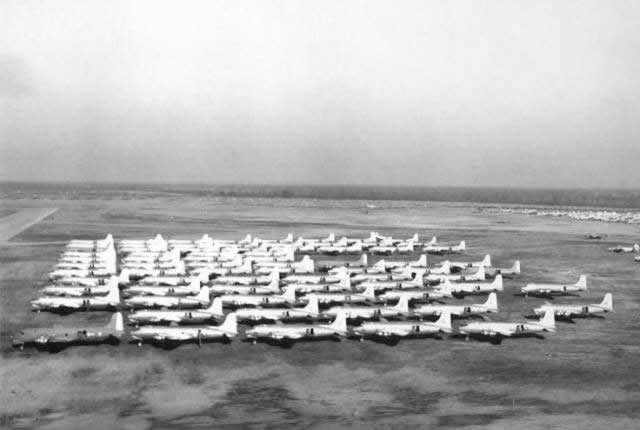 |
|
Interactive Map of Walnut Ridge Airport Area
Map of locations of active and post-WWII airplane boneyards and plane storage facilities in the United States
For More Information about Walnut Ridge
- City of Walnut Ridge, Arkansas
- Walnut Ridge Municipal Airport
- Wings of Honor Museum - Walnut Ridge Army Flying School Museum
